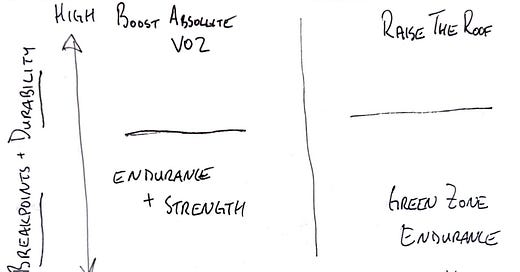Over the last few weeks we’ve developed a framework for your current physiology. We discussed thinking long term, as well as different athlete profiles. Given that our time, energy and capacity are limited, we need to decide which aspect of VO2 Max to target. I made the table (above) to help you decide.
The y-axis says “Breakpoints & Durability.” These are quantitative and qualitative concepts. We can measure our breakpoints with lactate testing, then benchmark ourselves over time to assess our durability.
Simple questions to ask: How fit am I relative to my potential, and how deep is my fitness?
The x-axis is engine size, from small to large. Small and large are relative to our potential as well as our race category & peers.
Individualization of Approach
Big Engine with High Breakpoints: Will benefit from classic raise-the-roof VO2 Max training in the Red Zone. For more, see here and here in our Testing Series.
Small Engine with High Breakpoints: Will benefit from focusing on boosting Absolute Work Rates and Maximal Power. These athletes should consider nutritional counseling and experiment with energy positive, anabolic blocks.
Big Engine with Low Breakpoints: These athletes have more VO2 Max than they can currently access. Focus on Green Zone Endurance, skills and a little bit of quickness training. It does not make sense to spend energy doing hard training in this category. The focus should be consistent volume around LT1. These athletes will see rapid decoupling at moderate efforts.
Small Engine with Low Breakpoints: Use a balanced, seasonal program that works through all types of training. For intense training, many of these athletes have excellent tolerance of Tempo, which can be exploited for structuring their peppy workload.
The key point I want to make…
Most everyone acts like they are a Big Engine / High Breakpoint athlete.
As a result, there is a lot of energy wasted, especially if you used to fall into this category and have fallen out of shape. Former collegiate athletes, former elite athletes, former swimmers, hybrid athletes shifting towards endurance events…
How will you know you need to modify your approach? Your consistency is going to suffer and your intense training will beat you down.
When we have the correct approach, our intense sessions will lift us up. Meaning, our VO2 Block will see mood and performance in all zones improve. If that’s not happening then you’ve chosen an approach that doesn’t match your current needs OR your non-training stress is preventing you from adapting to your training.
Managing Maladaptation
When we aren’t adapting, it’s time to put on our thinking caps.
Did I select an incorrect approach for my needs?
Did I go bananas with my dosing?
Is my plan too stressful given everything else in my life?
Approach
If you are low-breakpoint athlete doing a lot of Red Zone work then your approach needs to change. You’ll need to back off and focus on Metabolic Fitness.
For example, with my own return to training, it was two years1 of focusing on Metabolics before I benefited from Tempo / Zone 3 and nearly 1,000 days before I tolerated Red Zone training.
The above is common. Less common are a small engine athletes, who are going easy all the time. These athlete will need to get comfortable going very hard, in the gym and with sport-specific resistance training.
Dosing
Sometimes there’s nothing wrong with the approach. The issue lies in the workout structure and execution. If you are doing the correct type of training for your needs, but not seeing a lift in mood & performance then change the workout structure. This can mean a lower/slower interval targets, a smaller total dose and/or more time between intervals.2
Remember, we don’t want to get great at doing intervals… we want to create a positive adaptation that results in improved race performance. The greatest benefit we get in our program is to movement from zero-to-some. We don’t need to be crushing ourselves with heroic workouts.
Adaptation
There are times when you will notice you have stopped adapting positively to your training. This can be due to life stress, nutrition or a combination of other factors.
The cause is not always clear. The video below is a case study where the athlete (me) stopped adapting and needed to consolidate fitness before trying again.
Final Tips
Do not start a VO2 Block tired.
Here’s the progression I like to use:
One Month Off Season
Season Start Up3
Six to Eight Weeks of Endurance & Strength Focus
Schedule A Maximal Test to confirm max heart rate and max lactate values.4
VO2 Block
Next time, I’ll bring together all our VO2 Max sessions in a single location. I’ll also share a protocol I used this past spring.
Back to The Physics of Performance
Back to Table of Contents
Two years and ~1,500 aerobic hours.
Next week I will share a case study on modifying targets, load and rest intervals.
The fatigue paradox is explained in our Lactate Testing chapter. A tired and depleted athlete can present as fit during their submax work but will lack the ability to hit high lactate and heart rate values.




